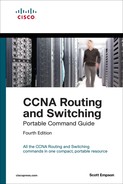Book Description
Here are all the CCNA-level Routing and Switching commands you need in one condensed, portable resource. CCNA Routing and Switching Portable Command Guide is filled with valuable, easy-to-access information–and it’s portable enough to use whether you’re in the server room or the equipment closet.
The guide summarizes all CCNA certification-level Cisco IOS Software commands, keywords, command arguments, and associated prompts, providing you with tips and examples of how to apply the commands to real-world scenarios. Throughout, configuration examples give you a better understanding of how these commands are used in simple network designs.
This book has been completely updated to cover all topics in the new ICND1 100-105, ICND2 200-105, and CCNA 200-125 exams. Use this quick reference resource to help you memorize commands and concepts as you work to pass the CCNA Routing and Switching certification exam. Coverage includes
Network Fundamentals: Subnetting, VLSM, route summarization, cables/connections, CLI
LAN Switching: Switch configuration, VLANs, VLAN trunking protocol, inter-VLAN communication, STP, EtherChannel
Routing (IPv4/IPv6): Router configuration, static routing, RIPng, EIGRP/EIGRPv6, OSPFv2/OSPFv3
WAN: Point-to-point protocols, eBGP, GRE tunnels, QoS
Infrastructure Services: DHCP, FHRP, HSRP, NAT
Infrastructure Security: Switch port security, ACL traffic management, device hardening
Infrastructure Management: Backup/restore, password recovery, CDP, LLDP, IOS tools, device monitoring, IOS licensing, troubleshooting
Quick, offline access to all CCNA Routing and Switching commands for research and solutions
--Logical how-to topic groupings for a one-stop resource
--Great for review before CCNA Routing and Switching certification exams
--Compact size makes it easy to carry with you wherever you go
--“Create Your Own Journal” section with blank, lined pages enables you to personalize the book for your needs
--“What Do You Want to Do?” chart inside the back cover helps you to quickly reference specific tasks
This book is part of the Cisco Press Certification Self-Study Product Family, which offers readers a self-paced study routine for Cisco® certification exams. Titles in the Cisco Press Certification Self-Study Product Family are part of a recommended learning program from Cisco that includes simulation and hands-on training from authorized Cisco Learning Partners and self-study products from Cisco Press.
